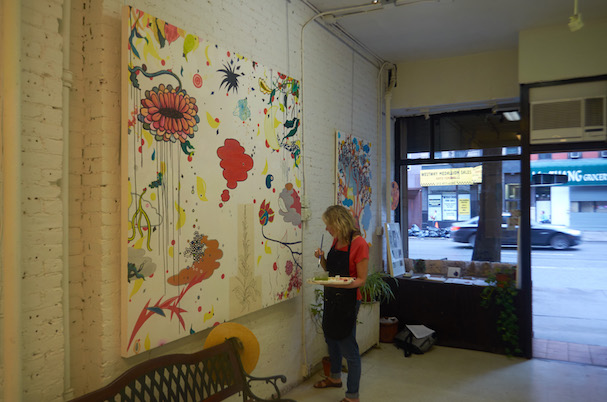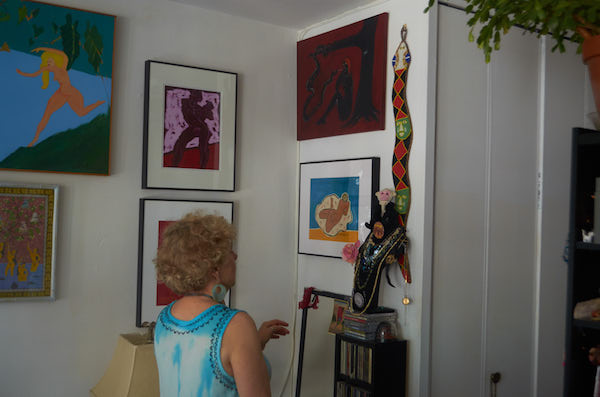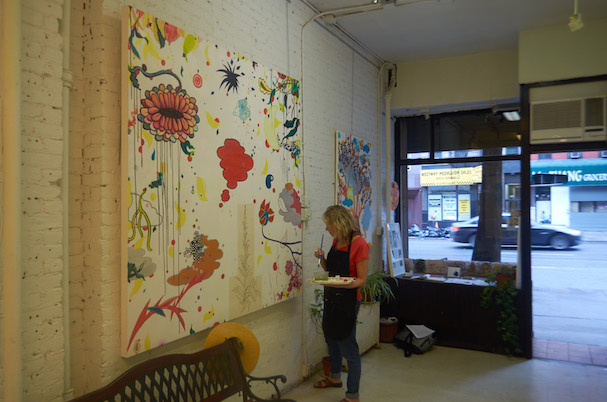
BY NATHAN DICAMILLO | Janet Restino’s advice to young artists is that they live outside of Manhattan, yet she herself has been making art here since 1992. And she’s among the recent beneficiaries of an effort encouraging like-minded souls to maintain their base in Hell’s Kitchen.
“A lot of the creative force in Manhattan has been forced out due to real estate costs rising,” Alan Boss, owner of Hell’s Kitchen Flea Market, said. “It’s sad to see them abandon their studios on the West Side so we could have another bank or pharmacy.”
On Aug. 1, the Hell’s Kitchen Foundation, the flea market’s community sponsor, announced that Restino and nine other artists living in Hell’s Kitchen have won grants of between $500 and $5,000 to support their work. The grants, in their second year, are based on the quality of the artists’ work as well as their financial need. The foundation, funded by the flea market, plans to approach businesses about hanging art for a fee, “having local businesses support local artists,” its chair, Inge Ivchenko, explained.
The foundation and the artists it supports are alarmed about gentrification displacing artists and their studios in Hell’s Kitchen. “Just to get into a gallery they need a connection or have to pay the gallery,” Ivchenko said. “The stereotype of the starving artist who’s struggling is very true.”
Many artists arrived in Hell’s Kitchen already displaced from other parts of Manhattan, like SoHo and Chelsea. In SoHo, from the 1950s through the ‘70s, loft buildings with plentiful lighting attracted artists, who were later priced out of a neighborhood they popularized. Art, like other creative professions, requires space, and many artists can’t live and work in the same building. The distance between home and studio can be great.
“If you have an idea and its 11 o’clock at night, you can’t just work on it then,” Ivchenko said. “When you live like that, you have to be more structured with your time.” She added, “If you’re fortunate enough, you can work in your own apartment. But if you’re a sculptor, you have a much bigger project.”
Some of Restino’s art remains in a storage unit in Philadelphia, where she went to art school. She’s “worn many hats” while living in Manhattan, creating greeting cards, T-shirts, and political buttons to get by. Both Restino and another winning grantee, Nick Stavrides, said they have rent-stabilized apartments, but artists now arriving in Hell’s Kitchen must often contend with paying market rate rents.

Stavrides moved into Hell’s Kitchen in 1993 — when broken glass covered the streets because of kids breaking into cars to steal stereos. “There were still places to live because it was underdeveloped,” Stavrides said. Starting out, he kept his art in a speakeasy in his building’s basement, and he bartended to make ends meet. Now, he borrows a friend’s studio.
Jill Slaymaker came to the city in 1992 with no apartment and no job, surviving on tips from cocktail waitressing. She paid $275 a month for the first 18 years she lived here, subletting a Chelsea apartment from a photographer who wanted to live elsewhere but also use the apartment as a workspace. When Slaymaker met her husband, a musician, she moved into Manhattan Plaza, which provides subsidized housing for performing artists. “We’re both part-time teachers,” she said. “We’re making it because of that housing.”
Shawn Wickens works in the kitchen of the apartment he shares with his girlfriend, who “puts up with a lot,” he said. Wickens moved to the city in 2004, and said he only took note of the flight of artists from Manhattan the past five or six years. But he’s also seen the number of grants increase. “Once I noticed people leaving, I also noticed a more vocal push to put money in the hands of artists, but the competition is fierce for it,” he said.
Wickens attributes his success as an artist to finding a community of positive people. “Surround yourself with good people who will lift you up when your spirits are down and do the same for others,” he advised young artists arriving in New York.
Mahmoud Hamadani moved here in 1996, when he “didn’t know what to do next.” After working as a diplomat and an actuary, he decided he would try his hand at writing. But to relax, he began to draw. “It was a curiosity that became an interest, an interest that became an obsession, and an obsession that turned into a career,” Hamadani said. He signed his first lease in Hell’s Kitchen seven years ago, after moving from sublet to sublet. For artists new to the city, Hamadani believes self-confidence is the most important part of making it.
On top of trying to work part-time jobs to stay afloat, artists have to be aware of how much exposure their work is getting, Ivchenko said. Getting art into a gallery, creating an online presence, and finding ways to do self-promotion for grants and awards are difficult and time-consuming challenges for artists.
“You don’t just need talent to do art,” Hamadani said. “It takes courage. You’re putting some of yourself into it, and that’s what makes it hard.”


































